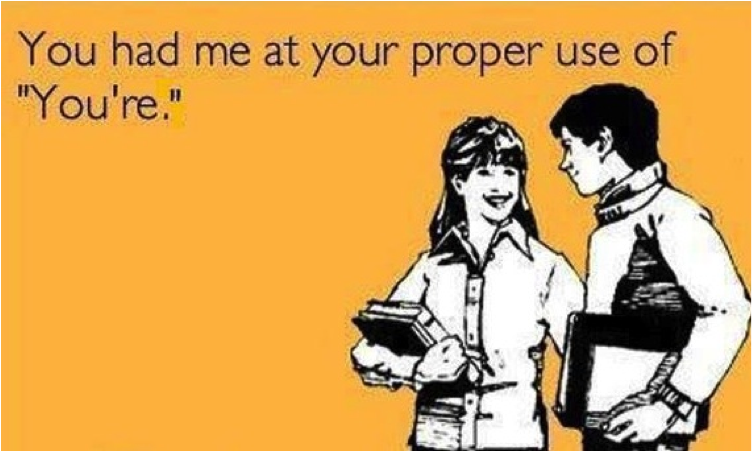Warning: this is about to get extremely boring. Read at your own risk.
Website copy is different than standard copy because the screen is farther away from the readers’ eyes than paper which causes the reader to blink half as often and tires the eyes. Website copy should be presented in smaller chunks so it’s easier on the eye. Here are some best practices when writing copy for a website:
General Best Practices
- Use no more than 2 examples in a series.
- Lead with the most important point you need to make (don’t write your way up to it).
Sentences
- 20 words or less
- Use ellipses, at times
- Use bulleted lists, at times
- Use sentence fragments, at times
Paragraphs
- 3 sentences or less
- Look for transitional words (furthermore, and, while, additionally, however, etc.)
Headlines
- Subject + Verb
- No more than 10 words
- Deliver a strategic message at a glance
- Use numerals
- Think advertising copy (not standard, narrative copy)
Content SectionsAsk yourself: How much info do I have on this particular topic?
- Run no longer than a screen & a half
- If you can say it all in one screen or so, you can write the same way you would for print.
- If longer than a screen & a half: (a) Break up content over several screens, (b) Lead screen has intro/summary and links to rest of details on other screens
- Sometimes people will scroll beyond a screen and a half especially when you: (a) Present info in a list format, (b) Use images to guide the eye downward, (c) Use subheads to break up the text
Blurbs
- 1 or 2 sentences long
- Lure readers into your content
- Use personal pronouns (we, you, us, they)
- Explain how content might benefit reader
- Pose an interesting question
- Use words that imply exclusivity (tips, secrets, reveal, strategies, divulge, unveil, etc.)
- Use compelling vocab (see chart below for examples)
|
Instead of: |
Consider: |
|
Put |
Position, site |
|
Target |
Pinpoint, zero in on |
|
Talk |
Chatter, drone, harangue |
|
Manage |
Steer, captain, direct |
|
Emphasize |
Showcase, spotlight, underscore |
|
Implement |
Execute, adopt, apply |
|
Turn |
Swivel, pivot, rotate, gyrate |
|
Throw |
Lob, hurl, fling, catapult |
|
Product Offering |
Suite, portfolio (of products) |
Avoid cliché words like:
- Leverage
- Deploy
- Mission-critical
- Optimal
- (Core) competencies
- Implement
- Enable
- Best of Breed
- Thing, something, anything, nothing, everything, etc. (Refer to the “thing” as what it really is: “One thing we need to do…” vs. “One step we need to take….”)
Quotes
- Only use meaningful quotes
- Use “said” for past tense quotes
- Use “says” for quotes that talk about current affairs
- Focus on human beings more than on inanimate objects.
- Humanize copy through the use of proper nouns (Governor Beebe), common nouns (taxpayers), and personal pronouns (they).
- Use a quote that (a) Reveals a vivid image or an interesting insight, (b) Is humorous or thought-provoking, (c) Expresses a feeling, (d) Has impacts by someone whose title is credible
- Don’t use a quote that: (a) States the obvious, (b) Is vague, trivial, or repetitive
- Use “who” when referring to a person (“We have customers who pay on time.”)
- Use “that” when referring to object (“This is the policy that I told you about.”)
Stories
- Avoid limp, dreary leads such as (a) Dry resuscitation of facts, (b) Asking a question that no one cares about (“Been wondering what our department has been up to?”) and (c) Here we go again lead (“It’s that time of year again…”)
- Interesting observation leads: (a) How your topic is similar to something else your reader is familiar with and (b) How your topic is different from what others might expect (or some ironic observation about it.)
- What makes your topic coverage-worthy? (a) If they are familiar with your topic, then how has the topic changed? (b) If they are not familiar with your topic, what makes the topic so unusual/intriguing?
- The You-are-there-lead: (a) Present tense, (b) Vivid, compelling vocab, (c) Action is underway from the beginning
- Surprise lead
- Suspense lead
- Question lead: Make sure its compelling, meaningful and relevant
- Quote lead
Effective Transitions
- Compare your new topic to a previous one
- Repeat a key word or phrase
- Use a geographical transition (In our European operations, on the other side of town, nearby, down the hall, in California, across campus, etc.)
- Use chronological transitions (a few minutes later, come September, the following quarter, by the year 2020, not too far down the road, later this year, etc.)
Effective Conclusions
- Avoid weak, cliff hanger endings
- Project out into the future
- Refer back to your lead
- Use an ‘umbrella” quote
- Direct people to related info posted online


